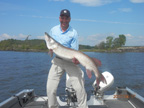
Posts: 3508
Location: Elk River, Minnesota | Hiya,
I am one who believes the hydrofoil is just a band aid for bigger problems in how the boat is rigged...most notably when a boat is significantly underpowered. I would say in your case that is not the issue, but more along the lines of a prop issue.
I noticed you mentioned you have tried different props. If I may ask, what have you tried and what were the results including hole shot and max rpms? How was handling, how was top speed?
In most cases where a boat has enough hp but still porpoises is due to a few possible factors, first and foremost an over-pitched prop. If the motor cannot get into the top 1/3 or so of the RPM range, there is not enough "umph" from the motor to keep the bow up, thus the bow falls, it then can catch, and up it goes again...thus the porpoise. Sometimes it has to do with how the prop is designed, how much cupping has been added, where the cupping is added and so forth.
The other issue that can potentially happen is for riveted boats, the back edge of the transom has gotten peened up a tad too much, thus making it too easy for the bow to rise too much and the motor cannot hold it, thus the porpoise again. In a welded hull, this is a bad thing since it cannot be adjusted as riveted hull can be. My alumacraft navigator 165 needed to be wedged to tame the bow down, and I have heard of a few others that needed that too.
On a fiberglass hull, it could be how the hull was formed, and be similar to a welded hull in that it cannot just be wedged to adjust. It would take much more than that...more or less the entire hull would have to be (I believe it is called) blue-printed, where they turn the boat over and make sure the hull is level along the length (where there are no gaps or bulges along the running hull as it would travel in the water). IF that is such the case, the gaps are filled or the bulges sanded down so the entire running length would sit flat with a straight edge. Definitely not an easy process, but it can be done.
With the tolerances of todays boat building, though, I would highly doubt that if your hull is fiberglass that this would be the case. It can be checked, though with a straight edge. More often than not, getting the right prop and pitched correctly will take care of the issue, saving you from drilling into the plate, or adding one of those fins.
If you can supply a little information on the RPM's, the props you have tried, etc, there might be something there to try before the drill comes out.
Steve |





